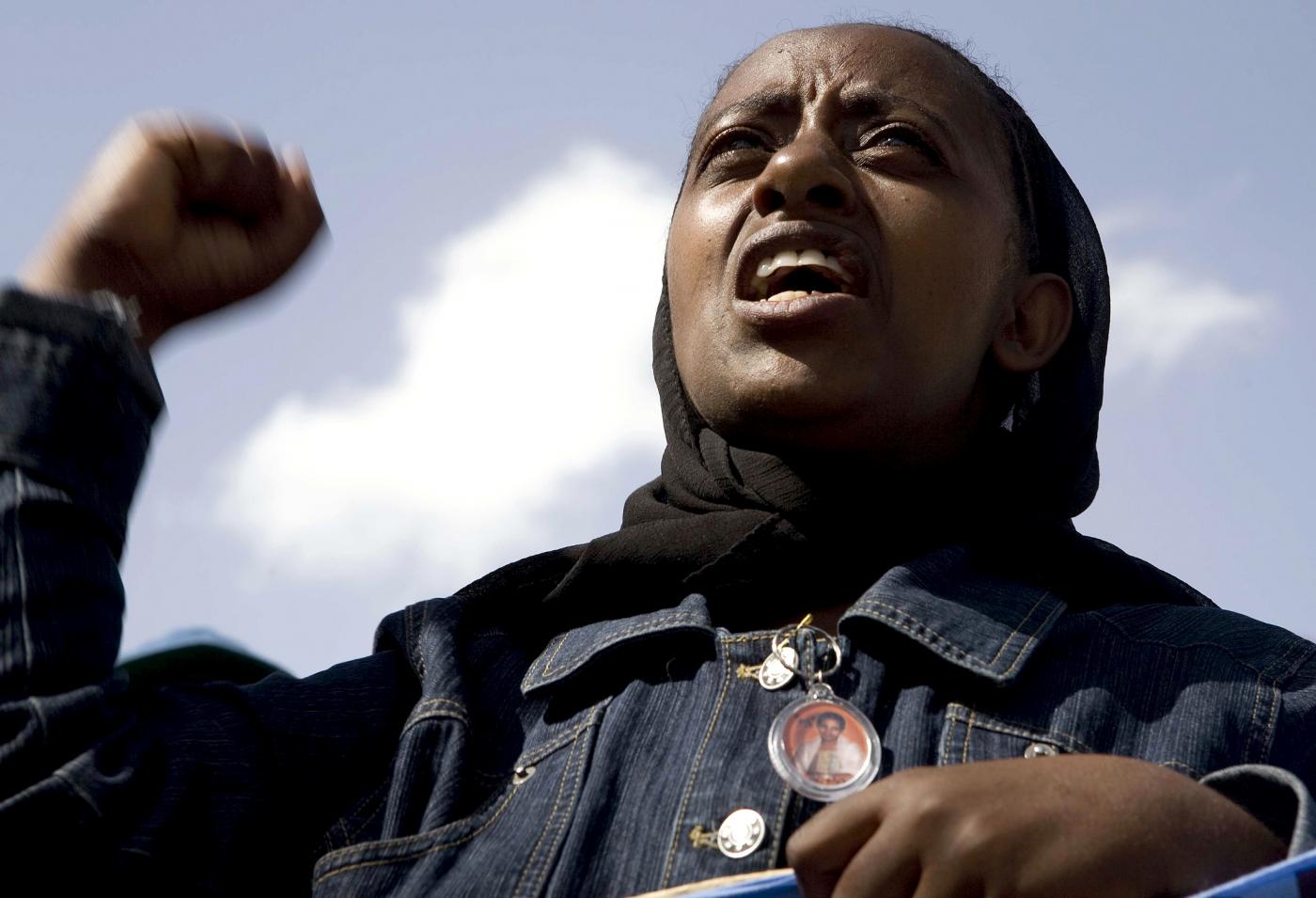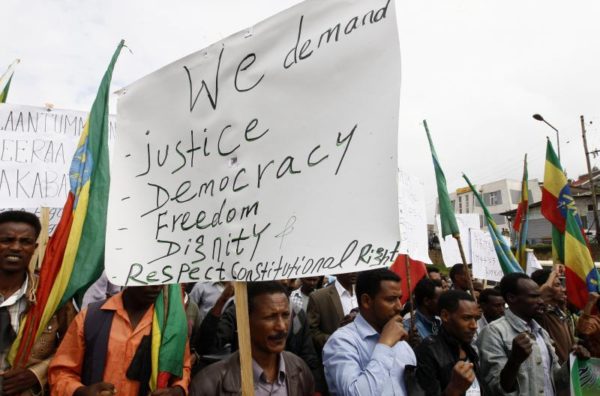PBS: Escaping Eritrea … [Read More...] about ካብ ውሽጢ ቤት ማእሰርታት ኤርትራ
Behind the Violence in Ethiopia
Will Its Experiment With Ethnic Federalism Work?

When U.S. President Barack Obama visited Africa a year ago, he ended his five-day tour by visiting Ethiopia, the continent’s second-most-populous country. He enthusiastically praised Addis Ababa for its role in regional peacemaking, most visibly in and between Sudan and South Sudan, as well for as its careful management of its diverse population; the country is home to tens of millions of Muslims and Christians, who, for the most part, live together peacefully. Obama also highlighted Ethiopia’s track record as a developmental state. In the last quarter century, it has lifted millions of people out of extreme poverty, cut child mortality rates for those under five by more than two-thirds, and overseen a decline in HIV/AIDS-related deaths by more than 50 percent. With Somalia haunted by the jihadist group al Shabab, South Sudan facing an all-out civil war, and Eritrea hemorrhaging thousands of young people fleeing to Europe via the Mediterranean, Ethiopia stood out as a bastion of progress and stability.
Yet today, Western diplomats and intelligence services are scrambling to assess a series of alarming protests in Ethiopia—what activists have labeled #ethiopianprotests—that are raising questions about whether Africa’s brightest growth story of the last decade is about to unravel. There have been months of demonstrations in Addis Ababa and the surrounding region of Oromia, where more than 35 percent of the Ethiopian population lives. Thousands of Oromo are contesting the unequal gains of the country’s developmental programs, even in the face of live bullets. But what has really instilled a sense of crisis is the violence that has rocked the Amhara region, where long-standing tensions boiled over into the ambush of a senior federal police commander and Amhara protesters, armed with guns, fighting street battles with soldiers. Nobody knows the official body count, but at least several hundred have died over the past few months.
Understanding the demonstrations, and their violent escalations by both security forces and protesters, requires a look at the ideology and political practices of the Ethiopian People’s Revolutionary Democratic Front (EPRDF), which has governed the country since its overthrow of a military dictatorship in 1991. The protests, which are neither a new phenomenon nor uniform in their demands, revolve around the fundamental question at the heart of Ethiopian politics in both the twentieth and the twenty-first centuries: how to turn a violently built, multiethnic former empire into a modern nation-state.
The answer for the EPRDF has always been a combination of ethnic federalism, revolutionary democracy, and state-led development. The party emerged out of decades of civil war, in which ethnically based rebel fronts confronted central (or rather, centralizing) governments in Addis Ababa, and it consists of a coalition of several of these groups. Among them, the Tigrayan People’s Liberation Front is the first among equals, even though it hails from a region where only seven percent of the population lives. Because the EPRDF came to power by drawing on resentment against the ethno-chauvinism of successive Amhara-dominated regimes, there was a real risk that the country would disintegrate into the kind of anarchy that characterized Somalia at the time. The Front’s solution was to grant self-determination, including the right of secession, to all of Ethiopia’s nations and nationalities: instead of denying ethno-regional identity, the EPRDF turned it into the cornerstone of its new state, hoping to draw out the venom from the imperial legacy of coerced assimilation. After decades of civil war, Eritrea peacefully left Ethiopia in 1993, but the other ethnic groups—including the Oromo, Tigrayans, and Amhara—remained, having been granted self-rule within regional states.This solution struck many constitutionalists as unworkable because it appeared to institutionalize inter-regional confrontation, thereby merely postponing Ethiopia’s dissolution. But because of the EPRDF’s Marxist-Leninist leanings, its interpretation of ethnic federalism was borrowed from Stalin’s template for how to organize a multinational federation: autonomous states can be kept together only by the ironclad grip of a vanguard party. This ideology continues to guide the Front today. As a result, the EPRDF dominates all regional states through satellite parties in an attempt to harmonize socioeconomic policies and prevent a resurgence of ethnic antagonisms. Political organization is everything for the Front: it rejects Western liberal democracy and instead practices “revolutionary democracy,” which prioritizes Leninist democratic centralism while recruiting millions of Ethiopians from all ethnic groups into party ranks. The role of the masses is hence framed in terms of revolutionary and administrative mobilization, not liberal participation.
Initially, the idea of retaining local language and identities, of nations and nationalities electing their own representatives, was genuinely popular.
The endurance of this ideology is also evident in the EPRDF’s long-term strategy to overcome ethno-regional rifts. Marxist ideology posits that ethnic identity is “false consciousness” and that the only true division in society is class; the political gamble underpinning the EPRDF’s developmental state project is that the material transformation of Ethiopia, particularly its rural areas, will ultimately lead people to forget the identity politics of old. The historical materialism of the Front, along with an organizational culture of secrecy nurtured by the armed struggle, also explains its distrust of liberal democracy: the people simply cannot yet be trusted with bourgeois freedoms.
For years, the triad of ethnic federalism, revolutionary democracy, and state-led development allowed the EPRDF to claim that it embodied legitimate and, above all, highly effective government: if Ethiopia receives several billions of dollars annually in overseas assistance it is not just because it has been an indispensable partner in the global war on terrorism but also because aid experts remain thrilled about the success of pro-poor government programs in education, health, and infrastructure. But now, the EPRDF is facing a crisis of authority, with both its legitimacy and its effectiveness in question.

Take ethnic federalism. Initially, the idea of retaining local language and identities, of nations and nationalities electing their own representatives, was genuinely popular. From the start, conflict within and between the new regions—often about the status of minorities within the redrawn administrative borders—was expected and, indeed, has claimed hundreds of lives annually since 1994; in that sense, #ethiopianprotests is nothing new. But the EPRDF always argued that ethnic federalism would decentralize violence, thus removing an existential threat to Ethiopian unity, and ultimately cause parochial attachments to wither under a new nation-state identity. A quarter century later, however, ethno-regional loyalties seems to have lost little of their mobilizing appeal, including their incendiary potential to be manipulated by zealous diaspora politicians. Ethnic-tinged antigovernment protests and violence have recently rocked places that have been transformed by economic growth, such as the Amhara capital, Bahir Dar, and Adama, Oromia’s most dynamic city, but have occurred for years in long-marginalized peripheries, such as Gambella, in western Ethiopia, and the Somali region. For all the talk of cross-ethnic alliances by some commentators, little unites the opposition: while Amhara chauvinists fly the flag of the old unitary state, Oromo secessionists demand the country’s breakup. Yet even if Ethiopians can’t agree on what constitutional reform should look like, ethnic federalism faces existential questioning from the peripheries to the center.
Revolutionary democracy has also run into trouble. The ethno-regional satellites that, with the Tigrayan People’s Liberation Front, compose the EPRDF have been increasingly delegitimized by corruption scandals and ineffective leadership. Their role in implementing ethnic federalism and developmentalism is pivotal but they are widely seen as feeble. Some Oromo and Amhara politicians within the Front are trying to use the protests in their regions to gain greater influence and resources, arguing that only they can act as middlemen between the overbearing center and the restless masses, but such scheming is resented by the politburo in Addis. Nationally, the EPRDF has large problems of its own; the 2012 death of Prime Minister Meles Zenawi, who expertly but ruthlessly ruled Ethiopia for 21 years, created a leadership vacuum that has not been filled, leading to institutional paralysis and Machiavellian jockeying in a party and country used to the strictest application of democratic centralism. For example, in March 2016, just after the new prime minister, Hailemariam Desalegn, apologized for the shooting of Oromo protesters and promised that the repression would end immediately, the Tigrayan-controlled security services intensified the crackdown, making their “boss” look powerless.
This highly combustible mixture—a divided political center, an ineffective and ambiguous regional elite, and the ideological legacies of Marxism-Leninism and the liberation struggle—is at the root of today’s unrest. To quell the masses, the EPRDF must face the ironic predicament in which it finds itself: economic development and ethno-regional empowerment have, predictably, lead to a classic revolution of rising expectations. The Front’s problem is not that ordinary Ethiopians deny the country’s progress—that so many of them can put their children in school or receive electricity at home. It is that millions of them—whether or not they participate in, or even approve of, the protests—feel that the current dysfunction within the political system is hampering an equitable partaking of the economic boom. In a striking parallel with the dilemma facing the Chinese Communist Party, with which it maintains excellent ties, the EPRDF knows that it has the most impressive track record of any Ethiopian government in modern history but that its control is being undermined by soaring levels of internal rent-seeking. If the party wants to survive, it must address the corruption that so angers its citizenry. In doing so, it will not only further raise expectations, but also be compelled to confront its delusions about what the theory and practice of ethnic federalism can achieve and, above all, question the privileges select elites have so far enjoyed.
